
Quick Tips
- Start with a boil.
- Remove the innards.
- Wipe out the inside.
- Cleaning microwave stains.
- Clean the outside.
- The finishing touches.
The first microwave I ever had was an ancient beast of a machine that was given to me by my auntie. I was in college, living in the dorms, and poor as all get out. So needless to say, I was thrilled. My new microwave gave me freedom. Freedom to eat whatever I wanted whenever I wanted (Spaghettios and ramen, of course, after all, I’m grown up!) and the freedom to avoid cafeteria food at all costs. After all, one can only eat boiled chicken patties on a bun for so many days in a row.
When that ol’ nuker came into my possession, it was a very clean microwave. I took care of that in very short order. Since the thing was so old, it wasn’t terribly powerful. It took a full 13 minutes to properly cook ramens. And Spaghettios? Forget about it. I never did figure out the proper timing for those bad boys. So naturally, I just cooked the piss out of them. I watched through the door and soaked up the rays until my dinner started boiling and splattering all over the inside of my microwave. I had those microwave walls painted orange in no time. So, armed with the few cleaning supplies I could actually afford at the time, I set out to figure out how to clean a microwave with what I already had. Turns out, over the last ten years or so that I’ve been outta college, I have yet to find a better way to clean a microwave oven. I don’t mean to brag, but this microwave cleaning method is simply the best. And although my new microwave isn’t very messy at the moment, in order to teach you how to clean a microwave oven my way, I’m gonna clean it anyway. After all, this is what grown ups do.
Steps to Cleaning a Microwave
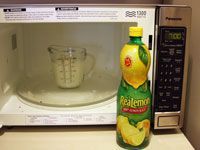 Start with a boil. When it comes time to clean a microwave, nothing sucks more than trying to remove those hard, crusty little cooked-on bits of delicious. That is, of course, unless you soften ’em up first. To accomplish this, tell them how nice they look and put 1 ¼ cups of water in a measuring cup with ¼ cup of lemon juice or the juice of one lemon. If you squeeze a lemon, leave one half of it in the cup for the boil. Put the measuring cup in the microwave and cook it on high for seven minutes. After the seven minutes, let it sit in there with the door closed for another five minutes. This allows the steam you created from the boil to soften things even more.
Start with a boil. When it comes time to clean a microwave, nothing sucks more than trying to remove those hard, crusty little cooked-on bits of delicious. That is, of course, unless you soften ’em up first. To accomplish this, tell them how nice they look and put 1 ¼ cups of water in a measuring cup with ¼ cup of lemon juice or the juice of one lemon. If you squeeze a lemon, leave one half of it in the cup for the boil. Put the measuring cup in the microwave and cook it on high for seven minutes. After the seven minutes, let it sit in there with the door closed for another five minutes. This allows the steam you created from the boil to soften things even more.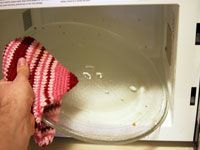 Remove the innards. The next step to clean a microwave is to take anything out of the microwave that is removable. Start with your measuring cup. Make sure to use a pot holder; it’s gonna be quite warm. Once the measuring cup is in hand, set it carefully aside for later use. Next, remove the cooking tray and its support (the little circular thing with wheels). Wash these two items by hand and either place them in the dish rack to dry or hand dry them and set them aside for reassembly once you have a clean microwave.
Remove the innards. The next step to clean a microwave is to take anything out of the microwave that is removable. Start with your measuring cup. Make sure to use a pot holder; it’s gonna be quite warm. Once the measuring cup is in hand, set it carefully aside for later use. Next, remove the cooking tray and its support (the little circular thing with wheels). Wash these two items by hand and either place them in the dish rack to dry or hand dry them and set them aside for reassembly once you have a clean microwave.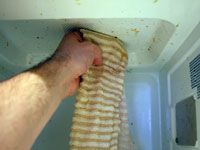 Wipe out the inside. Since all the crap in the microwave should be fairly soft already from the boil, the use of a commercial microwave oven cleaner should not be necessary. Unplug the unit and commence with cleaning microwave gunk. Grab a warm, damp dish rag (no point in wasting paper towels) and start by wiping down the inside top of the microwave. Once done there, clean the three sides, remembering to rinse out and re-moisten your dish rag in between each. Once you get down to the bottom, in addition to what was already there, there should be a fair amount of nastiness that has fallen from the top and sides. Wipe it out and shake your rag into the sink or trash can as needed. Once done with the bottom, rinse your rag, wring it out, squirt it with a little bit of white vinegar and wipe down the inside of the door. Next, inspect your work. If you find that you had a hard time cleaning corners and crevices, grab a couple cotton swabs, dip them in your hot lemon water, and take care of those areas with a little more precision.
Wipe out the inside. Since all the crap in the microwave should be fairly soft already from the boil, the use of a commercial microwave oven cleaner should not be necessary. Unplug the unit and commence with cleaning microwave gunk. Grab a warm, damp dish rag (no point in wasting paper towels) and start by wiping down the inside top of the microwave. Once done there, clean the three sides, remembering to rinse out and re-moisten your dish rag in between each. Once you get down to the bottom, in addition to what was already there, there should be a fair amount of nastiness that has fallen from the top and sides. Wipe it out and shake your rag into the sink or trash can as needed. Once done with the bottom, rinse your rag, wring it out, squirt it with a little bit of white vinegar and wipe down the inside of the door. Next, inspect your work. If you find that you had a hard time cleaning corners and crevices, grab a couple cotton swabs, dip them in your hot lemon water, and take care of those areas with a little more precision.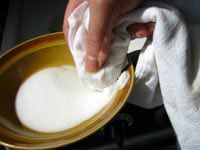 Cleaning microwave stains. Once you’re all done cleaning the inside of your microwave, inspect it closely for spots. Since it’s still gonna be unplugged and the light won’t be working, you might want to use a flashlight. Look very carefully over every surface. If you find a stain or two or three, don’t fret. Simply mix up a quick, thick paste of baking soda and water, dip a clean damp rag into it, wipe a blob of it onto the stain/stains and gently rub them out. After the spot has enjoyed a thorough rubdown, use a fresh damp rag to wipe away the baking soda.
Cleaning microwave stains. Once you’re all done cleaning the inside of your microwave, inspect it closely for spots. Since it’s still gonna be unplugged and the light won’t be working, you might want to use a flashlight. Look very carefully over every surface. If you find a stain or two or three, don’t fret. Simply mix up a quick, thick paste of baking soda and water, dip a clean damp rag into it, wipe a blob of it onto the stain/stains and gently rub them out. After the spot has enjoyed a thorough rubdown, use a fresh damp rag to wipe away the baking soda.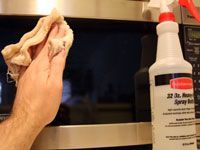 Clean the outside. Now that you know how to clean microwave insides, it’s important to learn how to clean microwave outsides. I’ll let you in on a little secret: it’s pretty simple. Straight water, vinegar or pretty much any multi-surface cleaner will do the trick. Whatever you use, just spray a little onto your rag and wipe down every surface you can get to. Remember to do the back of the microwave as well as the cord. They get dirty too.
Clean the outside. Now that you know how to clean microwave insides, it’s important to learn how to clean microwave outsides. I’ll let you in on a little secret: it’s pretty simple. Straight water, vinegar or pretty much any multi-surface cleaner will do the trick. Whatever you use, just spray a little onto your rag and wipe down every surface you can get to. Remember to do the back of the microwave as well as the cord. They get dirty too.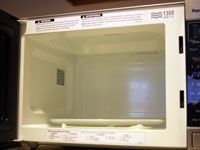 The finishing touches. Fantastic! You are now the proud owner of a clean microwave oven. Too bad you’re not done yet. But hey, you’re close. First, move the microwave and clean underneath it. I guarantee you will find at least six Cheerios and 10 to 12 macaroni noodles along with some dirt, dust, grease, and dried spills. Once its little section of counter is clean, return the microwave and reassemble it. Finally, open the microwave and leave it open for a couple hours to air it out. After the two hours has passed, close the door, plug it back in, and good luck resetting the clock.
The finishing touches. Fantastic! You are now the proud owner of a clean microwave oven. Too bad you’re not done yet. But hey, you’re close. First, move the microwave and clean underneath it. I guarantee you will find at least six Cheerios and 10 to 12 macaroni noodles along with some dirt, dust, grease, and dried spills. Once its little section of counter is clean, return the microwave and reassemble it. Finally, open the microwave and leave it open for a couple hours to air it out. After the two hours has passed, close the door, plug it back in, and good luck resetting the clock.
Using Safe & Natural Microwave Cleaners
I love grandmas (especially your grandma), but let’s be serious for a minute. Grandmas have a tendency to be bat shit crazy. And it has absolutely nothing to do with age. It simply comes from having grandchildren. Women, you see, have very sensitive and very advanced chemoreceptors that are able to detect grandchildren the very moment they are born, no matter the distance. Once that detection is made, a series of very specialized hormones is released that, within seconds of its release, triggers the instantaneous expression of the “crazy” gene. This gene, along with making grandmas among the funnest and coolest people to hang with, is also responsible for making them think they should be cleaning microwaves with harsh cleaners and scary chemicals. And that’s not good. We need to be able to eat the food that comes out of there without fear. I’m saying all this because, if you do feel the need to use a commercial microwave cleaner, there are safe options that your grandma, through no fault of her own, is oblivious to. Generally, all you need is a good all-purpose or multi-surface cleaner. I strongly recommend you look for brands such as Seventh Generation, Method, Ecover, or Simple Green. All of these cleaners are safe, organic, really easy to come by, and fairly inexpensive. Finally, if you require a little extra help removing stains from the inside of your microwave, consider using an oxygen bleach product such as OxiClean or Biokleen.
Household Organic Microwave Cleaners
 Vinegar. Plain old white vinegar is perhaps the best of all microwave cleaners. It cleans, cuts grease, deodorizes, and disinfects (thanks to its acetic acid) without risking anybody’s health. Buy it anywhere, put it in a spray bottle, spray a clean rag with it, and get to work. Vinegar will clean a microwave both inside and out. You can get it pretty much anywhere, or order the vinegar straight from Amazon.
Vinegar. Plain old white vinegar is perhaps the best of all microwave cleaners. It cleans, cuts grease, deodorizes, and disinfects (thanks to its acetic acid) without risking anybody’s health. Buy it anywhere, put it in a spray bottle, spray a clean rag with it, and get to work. Vinegar will clean a microwave both inside and out. You can get it pretty much anywhere, or order the vinegar straight from Amazon.
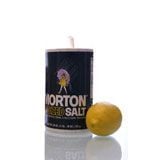 Lemon and salt.For cleaning a microwave that is heavily soiled, half a lemon dipped in table salt comes highly recommended as a microwave cleaner. Follow the advice given in the first step to the left, then cut a lemon in half, dip it in some salt, and start scrubbing. Scrub gently though; the salt is abrasive, and you don’t want to inadvertently damage your microwave. Once you’re done scrubbing, wipe the salt and lemon out with a clean, wet rag.
Lemon and salt.For cleaning a microwave that is heavily soiled, half a lemon dipped in table salt comes highly recommended as a microwave cleaner. Follow the advice given in the first step to the left, then cut a lemon in half, dip it in some salt, and start scrubbing. Scrub gently though; the salt is abrasive, and you don’t want to inadvertently damage your microwave. Once you’re done scrubbing, wipe the salt and lemon out with a clean, wet rag.
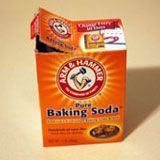 Baking soda.Microwaves have a strong tendency to pick up odors. You do, after all, use them to heat up a wide variety foods. And some of them, like fish and chicken, can get funky smelling—especially if there’s some splatter involved that doesn’t get cleaned up right away. When your microwave isn’t in use, keep a small box of baking soda in there to combat odors.
Baking soda.Microwaves have a strong tendency to pick up odors. You do, after all, use them to heat up a wide variety foods. And some of them, like fish and chicken, can get funky smelling—especially if there’s some splatter involved that doesn’t get cleaned up right away. When your microwave isn’t in use, keep a small box of baking soda in there to combat odors.